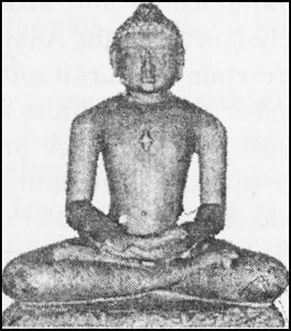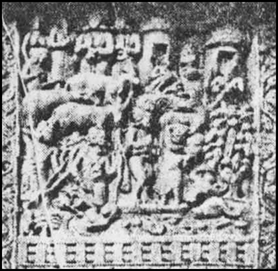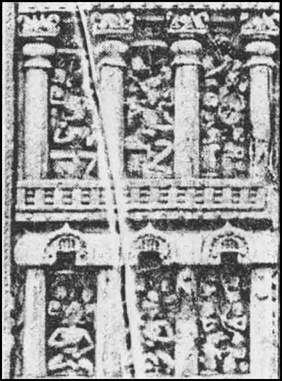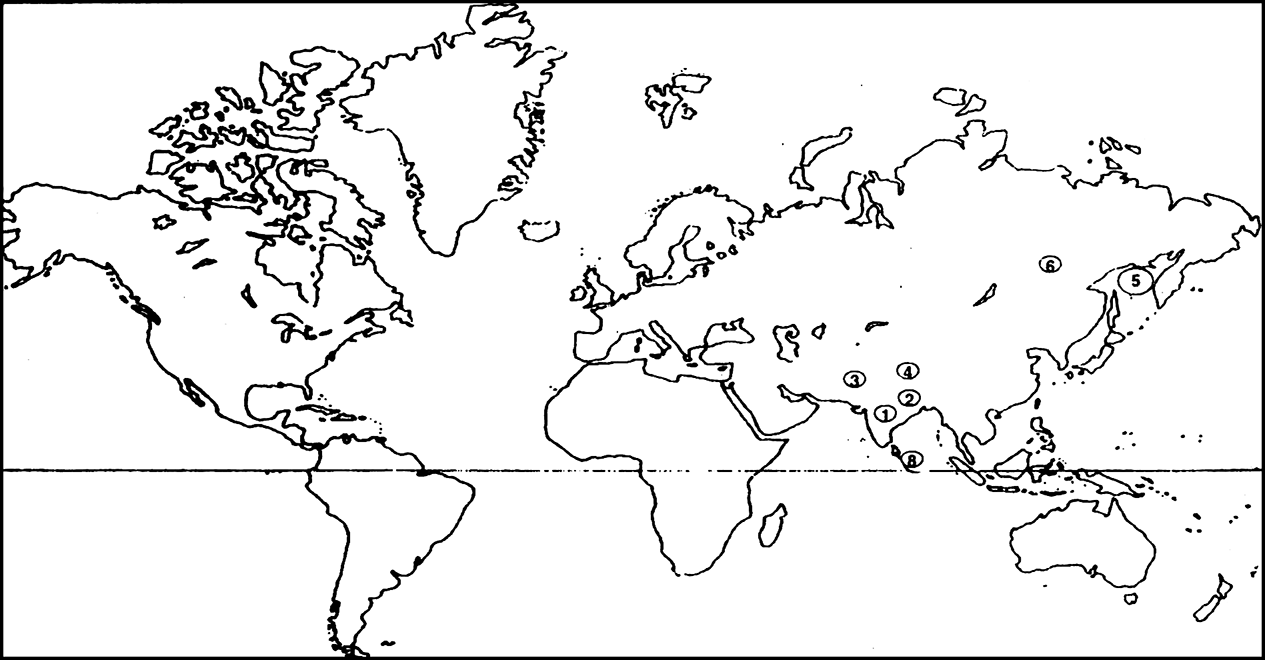Thinkers, Beliefs And Buildings
Describe the Tirthankars of Jainism. Discuss their main teachings about Jainism.
(i) Rishabhnath: He was the first Tirthankar of Jainism. According to a tradition, he was a king. He left his throne for his son named Bharat.
(ii) Parshavanath: He was the 23rd Tirthankar of Jainism. He was the son of Ashavsen, the King of Kashi. He renounced the world at the age of thirty. He attained true enlightenment after a deep meditation for only three months. He spent the rest of his life as a Dharam Guru. He died at the age of hundred. Fig. Mahavir Swami
(iii) Vardhman Mahavir: He was the 24th and the last Tirthankar of Jainism. He was born at Vaishali in the 6th century BCE. His childhood name was Vardhman. The name of his father was Siddharth and the name of his mother was Trishala. He was married to Yashodhara when he was quite young. He was blessed with a son. He left his house at the age of thirty. He practised penance for many years. He attained enlightenment at the age of fourty two. He spent the rest of his life in preaching religion. He died at the age of seventy two.

Teachings of Jainism and Tirthankars: The religion that the tirthankars preached came to be known as Jainism, the main teaching of this religion are as follows:
(i) Tri-Ratna: According to Jainism, the ultimate aim of human life is the attainment of Nirvana or salvation. There are three means to attain this nirvana—pure knowledge, pure character and pure philosophy. These three principles of Jainism are known as the Triratna.
(ii) Belief in Penance: The followers of Jainism believed in asceticism and penance. They gave more and more torture to their bodies. They believed that salvation could be achieved by giving more and more pain to the human body.
(iii) Non-violence: Jainism has emphasised ahimsa or non-violence in life. The followers of this religion believe that all things of this world are animate. So they considered it a sin to cause any injury to any human being, animal, plant or insect.
(iv) No Faith in God: The followers of Jainism do not believe in God though they accept the existence of God. They worship their Tirthankars in place of God.
(v) No Faith in the Vedas: The disciples of Jainism do not consider the Vedas as having divine knowledge. They do no consider the means of salvation mentioned in the Vedas as important. They believed that Yajnas were futile.
(vi) Believe in Soul: The followers of Jainism accept the existence of soul. According to them, the soul is immortal. Though it is in the body yet it is distinct and different from the body.
(vii) No Faith in Caste System: The followers of Jainism do not believe in casteism. According to them, all the people are equal. No one can be high or low on the basis of caste.
(viii) Belief in the theory of Karma: According to Jainism, the cycle of birth and rebirth is shaped through Karma. The next birth depends on the deeds done in the present life. So we should perform good deeds.
Sponsor Area
Some More Questions From Thinkers, Beliefs And Buildings Chapter
Were the ideas of the Upanishadic thinkers different from those of the fatalists and materialists? Give reasons for your answer.
Summarise the central teachings of Jainism.
Discuss the role of the begums of Bhopal in preserving the stupa at Sanchi.
Or
“The Begums of Bhopal played a significant role in preserving the remains of stupa at Sanchi.” Support this statement with suitable evidence.
Read this short inscription and answer the questions that follow:
In the year 33 of the maharaja Huvishka (a Kushana ruler), in the first month of the hot season on the eighth day, a Bodhisatta was set up at Madhuvanaka by the bhikkhuni Dhanavati, the sister’s daughter of the bhikkhuni Buddhamita, who knows the Tipitaka, the female pupil of the bhikkhu Bala, who knows the Tipitaka, together with her father and mother.
A. How did Dhanavati date her inscription?
B. Why do you think she installed an image of the Bodhisatta?
C. Who were the relatives she mentioned?
D. What Buddhist text did she know?
E From whom did she learn this text?
Why do you think women and men joined the Sangha?
To what extent does knowledge of Buddhist literature help in understanding the sculpture at Sanchi?
Figures I and II. are two scenes from Sanchi. Describe what you see in each of them, focusing on the architecture, plants and animals, and the activities. Identify which one shows a rural scene and which an urban scene, giving reasons for your answer.
Fig.: I

Fig. : II
Discuss the development in sculpture and architecture associated with the rise of Vaishnavism and Shaivism.
Discuss how and why stupas were built.
On an outline world map, mark the areas to which Buddhism spread. Trace the land and sea routes from the subcontinent to these areas.
Mock Test Series
Sponsor Area
NCERT Book Store
NCERT Sample Papers
Sponsor Area